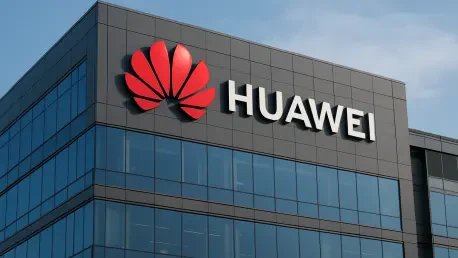Setting the Stage for a Tech Giant’s Struggle
In a striking turn of events, Huawei Technologies UK has seen its revenue plummet from a robust $1.7 billion in its peak years to a mere $159.6 million in the most recent financial reports, marking a staggering decline in one of the key Western markets. This dramatic fall underscores a broader trend of diminishing presence for the Chinese telecommunications giant in regions like the UK and beyond, driven by mounting geopolitical pressures. The significance of this shift cannot be overstated, as technology increasingly intertwines with national security and economic vitality in an era of global tension. This analysis delves into Huawei’s financial and operational challenges in the UK, explores the reasons behind stringent Western policies, examines the company’s resilience on a global scale, and considers the future implications of this ongoing saga.
Examining Huawei’s Downfall in the UK
Financial and Operational Collapse
Huawei Technologies UK has faced a relentless downward spiral, with revenues dropping to $159.6 million in the latest figures, reflecting an 18% year-on-year decline from previous levels. This sharp contraction from a high of $1.7 billion several years ago paints a grim picture of the company’s shrinking footprint in the region. Gross profit has similarly taken a hit, falling by 21.4% to $32.7 million, while profit after tax slumped by over 26% to just $8.4 million, highlighting the severe financial strain imposed by external pressures.
Beyond the numbers, the operational impact is equally stark, as the workforce has been slashed from a peak of 885 employees to a skeletal 176 in recent times. These figures, drawn from credible company filings, reflect not just a localized issue but a broader trend of retreat across Western markets. The reduction in staff and revenue signals a forced scaling back of ambitions, driven by policies that have effectively curtailed Huawei’s ability to operate at full capacity in these regions.
Consequences of Regulatory Restrictions
The root of this decline lies in legislative measures such as the UK Telecommunications (Security) Act, enacted a few years ago, which banned Huawei equipment from 5G networks and set a deadline of 2027 for the removal of existing technology. This policy was heavily influenced by actions from across the Atlantic, where a 2019 executive order under a previous US administration barred Chinese telecom gear, a stance that has been upheld by subsequent leadership. The continuity of such restrictions suggests a long-term barrier to Huawei’s market access in these critical areas.
As a direct result, Huawei has been compelled to withdraw from key sectors like enterprise technology, including servers and networking equipment, within the UK. The focus has shifted to maintaining existing network services and pushing consumer products like smartphones and wearables, though even these efforts face significant headwinds. This strategic retreat illustrates how policy shifts have reshaped the company’s operational landscape, forcing a reallocation of resources away from once-lucrative markets.
Unpacking Geopolitical and Security Dynamics
Scrutiny Over Security Risks
At the heart of Huawei’s challenges are deep-seated concerns over national security, amplified by reports from entities like the Huawei Cyber Security Evaluation Centre in collaboration with UK intelligence bodies. These assessments have criticized the company’s software practices, pointing to potential vulnerabilities, though no definitive evidence of malicious intent has been uncovered. Such critiques fuel a narrative of caution, shaping public and governmental perceptions despite the absence of concrete proof of wrongdoing.
Allegations of links to the Chinese Communist Party and fears of espionage further complicate Huawei’s position, even as the company steadfastly denies any such connections. These concerns, while unproven, have created a climate of distrust that overshadows Huawei’s technological contributions. The tension between perceived risks and the lack of tangible evidence presents a nuanced challenge for policymakers navigating this contentious space.
Expert Insights on Security vs. Economic Trade-offs
Industry expert Steve Brazier has articulated a critical perspective, emphasizing that Western nations are prioritizing national security over economic gains, even at the expense of technological progress. According to Brazier, the decision to exclude Huawei from 5G infrastructure in the UK has led to delays in network rollouts and diminished performance, impacting connectivity and innovation. This trade-off, while deemed necessary by some, carries quantifiable costs in terms of lost productivity and missed opportunities.
The broader implications of this stance reveal a strategic dilemma, where the push for security may hinder advancements that could benefit economies in the long run. Brazier’s commentary underscores the complexity of balancing immediate protective measures against the potential for slower growth in critical tech sectors. This dynamic continues to shape the discourse around Huawei’s role in Western markets, highlighting the intricate interplay of politics and progress.
Projecting Huawei’s Path in Western Markets
Challenges and Cautious Forecasts
Looking ahead, Huawei’s outlook in the UK remains guarded, with ongoing economic difficulties and unrelenting regulatory constraints likely to impede any significant recovery. The stringent policies currently in place show little sign of easing, suggesting that the company will struggle to regain its former standing in this market. This persistent exclusion poses a formidable barrier to rebuilding trust and operational capacity in the region.
Despite these hurdles, there are glimmers of strategic adaptation, as Huawei explores opportunities beyond Western borders. In regions like Asia Pacific, recent data indicates a robust 22% year-on-year growth, demonstrating the company’s ability to pivot and thrive where restrictions are less severe. This contrast highlights a dual reality: while Western markets remain hostile, Huawei’s global presence offers a buffer against total decline.
Wider Implications for Technology and Economy
The ripple effects of Huawei’s exclusion extend beyond the company itself, impacting Western nations’ technological trajectories. Slower 5G deployment, as noted by experts, translates into economic costs through reduced efficiency and innovation, affecting industries reliant on cutting-edge connectivity. This setback raises questions about the long-term competitiveness of regions that prioritize security over collaboration with global tech leaders.
On the flip side, Huawei’s strengths in telecommunications, artificial intelligence, and Internet of Things continue to position it as a formidable player worldwide. The potential for growth in less restrictive markets could sustain its influence, even as key Western territories remain out of reach. This dichotomy suggests a future where global tech landscapes are increasingly fragmented, shaped by geopolitical fault lines rather than unified progress.
Reflecting on a Divisive Tech Journey
Looking back, Huawei’s steep financial and operational decline in the UK stands as a stark testament to the power of Western bans fueled by security apprehensions, even as the company showcases resilience on a global scale. The intricate dance between technology and geopolitics plays out vividly in this saga, revealing the profound challenges of operating in a polarized world. Moving forward, a critical next step involves fostering dialogue to strike a balance between safeguarding national interests and harnessing technological advancements, ensuring that policies do not stifle innovation. Additionally, exploring frameworks for conditional collaboration with companies like Huawei could mitigate economic drawbacks while addressing security concerns. This evolving landscape demands careful consideration of how to navigate such tensions, paving the way for a more integrated yet secure global tech ecosystem.









